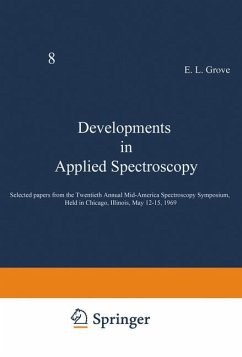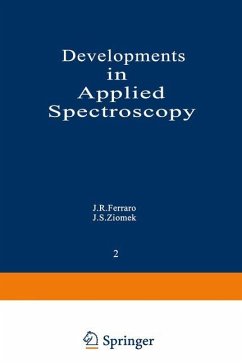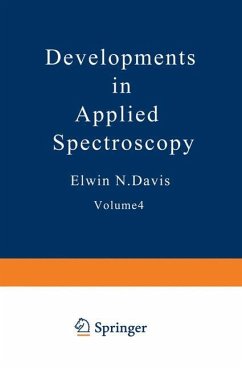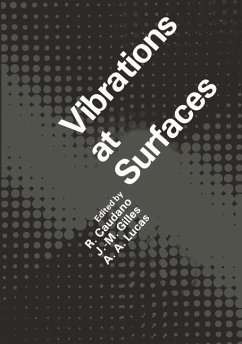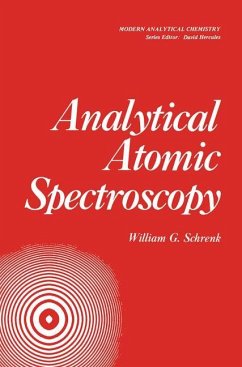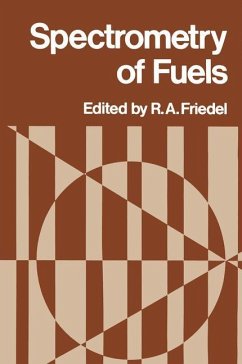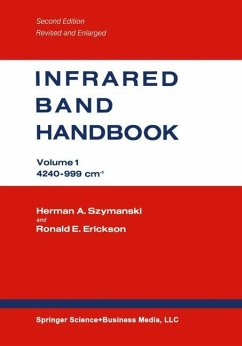
Ion-Molecule Reactions
Volume 2
Herausgegeben: Franklin, J. L.

PAYBACK Punkte
20 °P sammeln!
of Volume 2.- 8. Flowing Afterglow Studies.- 1. Introduction.- 2. Studies Bearing on Intermediate Complex Formation in Thermal Energy Collisions.- 2.1. Temperature Dependence of Slow Ion¿Molecule Reactions.- 2.2. Three-Body Reaction Rate Constants.- 2.3. Rotational Excitation in Ion¿Neutral Reactions.- 2.4. Miscellaneous Considerations of Intermediate Complex Processes.- 3. Studies Bearing on Negative-Ion Resonance Formation.- 4. Studies Bearing on Energetics.- 5. Conclusions.- References.- 9. Ion Cyclotron Resonance Spectrometry.- 1. Introduction.- 1.1. General Characteristics.- 2. Theoreti...
of Volume 2.- 8. Flowing Afterglow Studies.- 1. Introduction.- 2. Studies Bearing on Intermediate Complex Formation in Thermal Energy Collisions.- 2.1. Temperature Dependence of Slow Ion¿Molecule Reactions.- 2.2. Three-Body Reaction Rate Constants.- 2.3. Rotational Excitation in Ion¿Neutral Reactions.- 2.4. Miscellaneous Considerations of Intermediate Complex Processes.- 3. Studies Bearing on Negative-Ion Resonance Formation.- 4. Studies Bearing on Energetics.- 5. Conclusions.- References.- 9. Ion Cyclotron Resonance Spectrometry.- 1. Introduction.- 1.1. General Characteristics.- 2. Theoretical Basis for ICR.- 2.1. Ion Motion in a Magnetic Field.- 2.2. Ion Motion in an rf Electric Field Normal to a Magnetic Field.- 2.3. Ion Kinetic Energy.- 2.4. Power Absorption.- 2.5. Ion Drift.- 2.6. General Behavior of Ions in the ICR Cell.- 2.7. Ion Trapping.- 2.8. Methods of Ion Detection.- 3. Ion Intensities.- 3.1. Low Pressure¿No Collisions.- 3.2. Simple Spectra.- 3.3. Relative Intensities.- 3.4. Low-Pressure Reactions (Autoionization¿Unimolecular Fragmentation).- 3.5. Nonreactive Collisions and Charge Exchange.- 3.6. Ion¿Molecule Reactions.- 3.7. Rate Constants.- 3.8. Extension of ¿Low-Pressure¿ Theory to Include Tertiary Ions.- 3.9. Effects of Space Charge.- 4. Double Resonance.- 4.1. General Description.- 4.2. Use of Double Resonance for Identifying Specific Reactions.- 4.3. Blanking Experiments.- 4.4. Variation of Product Distribution with Ion Energy.- 5. Other ICR Techniques.- 5.1. Ionization Efficiency Curves.- 5.2. Electronic Spectra from Scattered Electrons.- 6. Summary.- References.- Appendix I.- Appendix II.- Appendix III.- 10. Mass Spectra and Appearance Potentials Studied by Use of Charge Exchange in a Tandem Mass Spectrometer.- 1 Introduction.- 2. Charge-Exchange Processes.- 3. The Tandem Mass Spectrometer of Perpendicular Type.- 4. Recombination Energies of Positive Ions.- 5. Recombination Energies of Doubly-Charged Positive Ions.- 6. Transfer of Translational Energy in Charge Exchange.- 7. Some Charge-Exchange Mass Spectra.- 7.1. Ethane.- 7.2. Ethylene.- 7.3. Methanol.- 7.4. Ammonia.- 7.5. Benzene.- 8. Appearance Potentials Measured by Use of Charge Exchange.- 9. Charge-Exchange Mass Spectra at Increased Pressure in the Collision Chamber.- References.- 11. Tandem Mass Spectrometric Studies of Ion¿Molecule Reactions.- 1. Introduction.- 2. Saturated Hydrocarbons.- 2.1. Propane.- 3. Unsaturated Molecules.- 3.1. Acetylene.- 3.2. Ethylene.- 3.3. Propylene and the Butenes.- 3.4. Vinyl Chloride.- 3.5. Cyclobutane.- 3.6. Structure and Reactivity of Cyclobutane Parent Ions.- 3.7. Collision-Induced Dissociation Reactions at Low Kinetic Energies.- 3.8. N+ Production from Dissociation of NO+.- 3.9. O+ Production from NO+.- 3.10. O+ Production from O2+.- 3.11. Evidence for Excited States from Ionic Dissociation Thresholds.- 3.12. Isotopic Experiments.- 4. Negative-Ion¿Molecule Reactions.- 4.1. Simple Inorganic Systems.- 4.2. Comparison of Rate Data from the Tandem Mass Spectrometer with Data Reported for Thermal-Energy Ions.- 4.3. Studies with Accelerated Ions.- 4.4. Reactions of O- with Organic Systems.- 4.5. Determination of Relative Acidities from Negative-Ion¿Molecule Reactions.- Acknowledgments.- References.- 12. Beam Studies of Ion¿Molecule Reactions.- 1. Introduction.- 2. Apparatus and Techniques.- 2.1. Survey of Typical Apparatus.- 2.2. Critique of Components.- 2.3. The Presentation of Data.- 3. Observations and Reaction Models.- 3.1. Direct versus Persistent-Intermediate Mechanisms.- 3.2. Direct Reactions.- 3.3. Reactions Involving Persistent-Intermediate Complexes.- 3.4. Criteria for Persistent-Complex Formation.- 4. Isotope Effects.- 5. Nonreactive Processes.- Acknowledgment.- References.- 13. Ionizing Collision Reactions of Electronically Excited Atoms and Molecules.- 1. Introduction: Definitions and Limitations.- 2. Background Work Prior to 1950.- 2.1. Associative Ionization.- 2.2. Penning Ionization.- 2.3. Excited-Pair Ionization.- 3. Modern Experimental Studies.- 3.1. Homonuclear Associative Ionization.- 3.2. Heteronuclear Associative Ionization.- 3.3. Rearrangement Ionization.- 3.4. Penning Ionization.- 3.5. Collisional Electron Release.- 3.6. Excited-Pair Ionization.- 4. Mechanistic Considerations.- 4.1. Reactant Identification.- 4.2. Mechanism of Reaction.- References.- 14. Electrical Discharges.- 1. Introduction.- 2. Determination of the Ionic Composition of Electrical Discharges.- 2.1. Radiation.- 2.2. Wire Probes.- 2.3. Beam Probing.- 2.4. Mass Spectroscopy.- 3. General Considerations.- 3.1. Ambipolar Effusion.- 3.2. Ion Sampling from Electrical Discharges.- 4. General Summary.- 4.1. Discharges in Noble Gases.- 4.2. Hydrogen Discharges.- 4.3. Nitrogen Discharges.- 4.4. Discharges in Oxygen and Iodine.- 4.5. Discharges in Other Gases.- References.- 15. Ions in Flames.- 1. Introduction.- 2. Experimental Techniques.- 3. Sources of Flame Ions.- 3.1. Thermal Ionization.- 3.2. Chemi-Ionization.- 3.3. Hydrocarbon Flame Ionization¿Positive Ions.- 3.4. Hydrocarbon Flame Ionization¿Negative Ions.- 4. Ion Loss Processes.- 5. Positive-Ion¿Molecule Reactions.- 5.1. Natural Flame Ions.- 5.2. Metallic Ions.- 6. Negative-Ion¿Molecule Reactions.- 6.1. Natural Flame Ions.- 6.2. Halogen and Metal Additives.- 7. Summary.- Acknowledgments.- References.- 16. Structure and Reactivity of Hydrocarbon Ions.- 1. Introduction.- 2. The Determination of Ionic Structures.- 2.1. Results Obtained from Nuclear Magnetic Resonance.- 2.2. Results Obtained from Optical Spectroscopy.- 2.3. Results Obtained from Mass Spectrometry.- 2.4. Results Obtained from End-Product Analysis.- 3. The Structures of Ions.- 3.1. The C4H8+ Ion.- 3.2. The C3H7+ Ion.- 3.3. The C4H9+ Ion.- 4. Reactivities of Ions.- 4.1. Effect of Ionic Structure on Reaction Rate.- 4.2. Effect of Structure on Reaction Channels.- Acknowledgments.- References.






